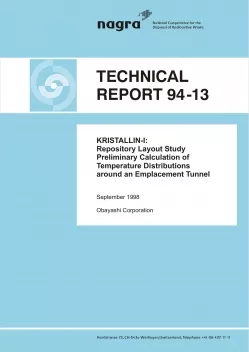
Technical Report NTB 94-13
KRISTALLIN-I: Repository Layout Study Preliminary Calculation of Temperature Distributions around an Emplacement Tunnel
The main aim of this study is to derive an understanding of the effect of tunnel spacing on temperature distributions around a HLW emplacement tunnel (diameter 3.7 m), located in the crystalline basement of Northern Switzerland. In Project Gewähr 1985, the tunnel spacing was tentatively set at 40 m, assuming that the extent of an undisturbed rock block was sufficiently large to accommodate a regular-shaped reference repository concept. The detailed geological investigations that were synthesized in the Kristallin-I Project provided preliminary indications of the size of undisturbed blocks that would be expected. Although indicating that there is a good chance of finding one or more suitable blocks, the actual block dimensions will not be known until the results of more detailed exploration are available. The chance of finding suitable blocks is, however, higher if the repository is designed with a compact layout. This provides the motivation for the studies on the extent to which the tunnel spacing can be reduced without compromising safety. Safety might be compromised either through loss of tunnel stability or through excessive temperatures arising in the near-field (and, particularly significantly, in the bentonite) due to radiogenic heat from the HLW. In the present study, tunnel spacing is varied to investigate its effect on the maximum temperature in the bentonite. Furthermore, the bentonite thermal properties and the presence of air gaps are also treated as variable parameters.
An important conclusion of this study is the recommendation that the horizontal spacing of emplacement tunnels should not be less than around 20 m, to ensure that tunnel spacing has little influence on temperature profiles. Modeled temperatures of all the near-field components tend to increase significantly if tunnel spacing is less than around 20 m. It should be noted that this conclusion is provisional, being based on idealized numerical calculations and model parameters. However, the authors feel that this represents valuable input for preliminary HLW repository design studies.
No significant temperature differences are observed between cases where the thermal properties of the bentonite are a function of variable water content (φ = 7 – 0%, Analyses No. 1 to 3) and those where water content is kept constant (φ = 2%, Analyses No. 4 to 6). Thus, it is concluded that temperature distributions in the near-field are insensitive to bentonite thermal properties. As further examples, Analyses No. 10 to 12 are performed with less conservative bentonite thermal properties. It is assumed that no air gaps exist in the bentonite and the tunnel spacing is kept at 20 m. It is then found that temperature profiles are sensitive to the thermal conductivity of the bentonite but insensitive to its thermal capacity.
Finally, it is worth noting that the feasibility of ensuring the absence of air gaps in the bentonite is uncertain and should be investigated because temperature distributions are sensitive to the presence of such gaps.
